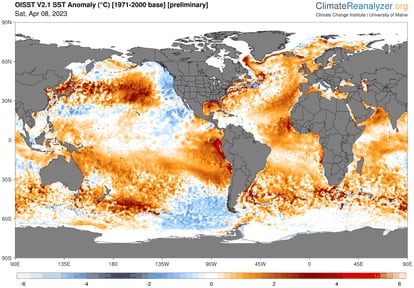The National Oceanic and Atmospheric Administration of the United States (NOAA, for its acronym in English) has verified that the average temperature of the seas and oceans has broken its record in April since there are official records, more than four decades ago: 21.1 °C
“We are entering unknown climatic and meteorological territory and crossing borders that have never been crossed before,” explains Francisco Martín León, meteorologist and popularizer.
The last time similar temperatures were reached —seven years ago— they were driven by the El Niño phenomenon, which cyclically warms the waters of the tropical Pacific, while on this occasion we are in a neutral climate period, so the cause points to the global warming due to greenhouse gas emissions.
Since 1981, NOAA has observed the behavior of Earth's open waters through satellites, buoys, and ships and estimates the surface temperature of seas and oceans (SST).
Although it is a relatively brief period in terms of climate, they are the most reliable data on the subject.
The agency's preliminary measurements show that on April 5, the seas between 60 degrees north and 60 degrees south exceeded 21 degrees, that is, all but the poles.
More information
Spain chains for the first time its fifth consecutive warm winter
The oceans are subject to two natural, changing and opposing cyclical climatic phenomena: El Niño, which warms the waters of the tropical Pacific, and La Niña, which cools them.
Three years of La Niña in that ocean have helped reduce temperatures and cushion the effect of increased greenhouse gas (GHG) emissions.
“In 2016 there was a warm phase with positive anomalies, which was called the Super Niño, which contributed so much to the rise in temperatures that the last record was reached.
However, at the moment La Niña has just ended, which means that even though it is in a neutral phase in the tropical Pacific, all modern records are being exceeded,” says Martín León.
According to the physicist, who for more than three decades worked at the State Meteorological Agency (Aemet), “global warming of anthropogenic origin is being stored in marine waters.
Between 80% and 90% of the excess energy ends up in the oceans.
That is why the seas are also suffering from heat waves, and as a result we are having abnormally high temperatures on these dates also in the North Atlantic and in the Mediterranean”.
In fact, the North Atlantic has exceeded 22 degrees, something unusual in spring, while the Center for Environmental Studies of the Mediterranean (CEAM) has also warned of exceptionally warm measurements in the sea bordering the Iberian Peninsula.
Warm anomalies of Earth's oceans and seas in April.ClimateReanalyzer.org
"The oceans enter unknown territory," Juan Jesús González Alemán, Senior State Meteorologist at Aemet, explained on his Twitter account.
“In their upward warming trend of the last decades, in this last week they have exceeded the barrier of 21ºC of surface temperature globally.
Something never seen since there are records [...] Something very striking is what is happening in the North Atlantic, where we have already had a month of record warming ”, he added.
In this sense, Martín León considers that "human beings are doping the atmosphere and oceans with the emission of greenhouse gases (GHG), and this has consequences for the meteorological system."
For this reason, when the next Niño arrives, foreseeably during the next summer, even higher temperatures are expected in the seas.
“The problem is that greenhouse gases already have more intense effects than El Niño or La Niña.
Before, when there was a La Niña phase, a certain cooling of the earth's temperature was noticeable, but it is less and less noticeable.
The warming of the seas causes them to generate more water vapor and this has effects on the meteorology: in these conditions, if a front, a storm or a DANA enters, it is very likely that it will produce very intense precipitation.
The warmer the waters, the more likely it is to generate extreme weather events.
In addition, these conditions increase the thermal stress of marine animals, which can affect the food chain and, ultimately, human nutrition.
March, the second warmest month in Spain in the 21st century
The month of March 2023 has been the second warmest and driest March of the 21st century in Spain, according to data published this Monday by Aemet.
Except for the first week of the month, temperatures were above normal values throughout the period, resulting in an average temperature 1.8 degrees Celsius above the average for the last two decades and barely 36% of normal rainfall.
The analysis of the state body indicates that it was close to 38ºC in the Canary Islands and that except in Galicia, the southwest of Castilla y León and Extremadura, as well as in the Balearic and Canary Islands, the month was dry or very dry.
In fact, this March has also been the third warmest and the sixth driest since the historical series began 62 years ago, according to the Aemet spokesman, Rubén del Campo.
The balance explains that the average temperature on the Peninsula was 11.6ºC, a figure that is 1.8ºC above the normal average value according to the reference period 1991-2020.
By areas, it was very warm in most of mainland Spain;
extremely warm in some parts of the Bay of Biscay and in the east, and warm in parts of the western third.
In the Balearic Islands it was very warm, while in the Canary Islands it was very warm or extremely warm.
You can follow CLIMATE AND ENVIRONMENT on
and
, or sign up here to receive
our weekly newsletter
Subscribe to continue reading
Read without limits
Keep reading
I'm already a subscriber









/cloudfront-eu-central-1.images.arcpublishing.com/prisa/WMF3AHNV5REGXPOPUY7PPSHQFQ.JPG)